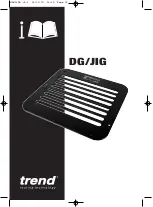
7
Recommended speeds for a 10mm
HSS drill:
Wood: 2000 RPM
Plastic: 1500 RPM
Aluminum: 1500 RPM
Brass: 1500 RPM
Cast iron: 1000 RPM
Mild steel: 800 RPM
High carbon steel: 600 RPM
Stainless steel: 300 RPM
Generally speaking, the smaller in
relation the drill bit, the greater the
RPM required.
Wood requires higher speeds than
metal.
Metal is usually drilled at slower
speeds; cutting oil is applied if
necessary.
Warning:
Always keep your hands well clear of
the rotating bit.
Do not remove chips and workpiece
parts until the machine is at a
standstill.
Always close the chuck guard and
pulley cover before you start the
machine.
When using a drill press vice, always
fasten it to the table.
Never do any works “freehand” (hand-
holding the work piece rather than
supporting it on the table), except
when polishing.
Support long workpieces with helping
roller stands.
Do not use wire wheels, router bits,
shaper cutters, circle cutters, or rotary
planers on this drill press.
Never cut magnesium-
high danger of fire!
7. Setup and adjustments
General note:
Setup and adjustment work may
only be carried out after the
machine is protected against
accidental starting by pulling the
mains plug.
7.1 Removing the Chuck and Arbor
Unplug the machine from the power
source.
Lower the quill (S, Fig 12) using the
down feed handle.
Rotate the spindle to align the key in
the spindle with the key hole in the
quill.
Protect the table surface.
Insert the drift key (T) into the aligned
slots and tap lightly.
Catch the chuck and arbor assembly
as it falls away from the spindle..
Fig 12
7.2 Adjusting the Depth Stop
To drill multiple holes at the same
preset depth, use the depth stop:
With the drill bit in the chuck, lower
the down feed handle to advance the
chuck to the desired point.
With your other hand, advance the
lock nuts (U, V, Fig 13) until they
touch the stop bracket (W).
Fig 13
The drill bit will now advance only to
this point.
7.3 Changing Spindle Speeds
Change speeds only while the drill
press is running.
To adjust the speed, rotate the shift
knob (K, Fig14) slightly counter
clockwise.
When the desired speed is reached,
tighten the shift knob.
Fig 14
7.4 Table Tilt Adjustment
Disconnect the machine from the
power source (unplug).
Caution:
Only loosen the hex cap bolt (X, Fig
15) slightly, otherwise the table
assembly will separate from the
column and fall.
To tilt the table, pull out the alignment
pin (Y).
The alignment pin will engage at 0, 45
and 90°.
Fig 15
Tighten the hex cap bolt






































